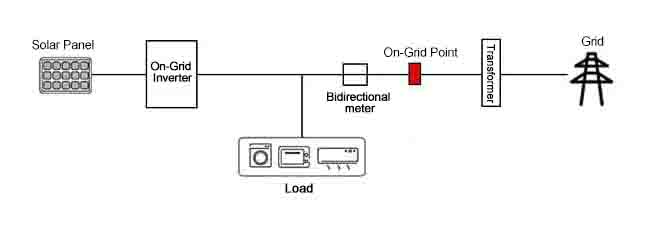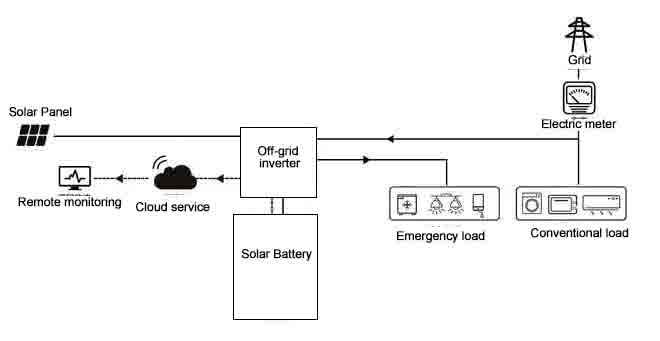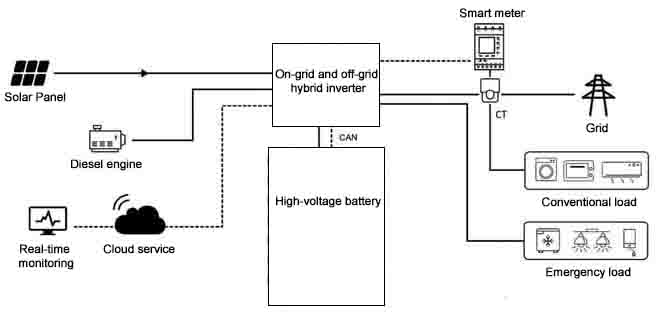Solar photovoltaic power generation is a technology that directly converts light energy into electrical energy. It is widely used in photovoltaic power generation projects, solar photovoltaic systems, photovoltaic power stations, and other fields. This technology is based on the photovoltaic effect of semiconductors. When photons come into contact with semiconductor materials, electrons are excited and current is generated, thereby realizing direct energy conversion. This process avoids the traditional thermal energy intermediary link, making it extremely efficient. Currently, solar photovoltaic power generation systems are mainly divided into four types based on different application needs: grid-connected power generation systems, off-grid power generation systems, grid-connected and off-grid energy storage systems, and multi-energy hybrid microgrid systems. The design and operation principles of each system are unique and can adapt to the energy supply needs in different scenarios.
1. Composition and Principle of Grid-connected Power Generation System
A grid-connected photovoltaic power generation system consists of several key components, including photovoltaic panels, grid-connected inverters, loads, bidirectional meters, grid-connected control cabinets, and the grid itself. Its operating mechanism is as follows: photovoltaic panels convert sunlight into direct current, and inverters convert this direct current into alternating current, which is then supplied to households. If the power generation exceeds household demand, the remaining power will be returned to the power company through the grid.

The characteristics of this system include:
It is connected to the grid and can transmit part or all of the electricity back to the grid.
When the grid fails or the power goes out, the photovoltaic system will also stop running. The inverter is designed with an anti-islanding function to ensure that the photovoltaic power generation system automatically shuts down when the grid goes out, to protect the safety of the grid.
Power supply at night still depends on the grid.
The system does not include energy storage devices.
2. Composition and Principle of Off-grid Power Generation System
An off-grid power generation system differs from a grid-connected system in that it operates completely independently of the grid. Its main components include PV modules, off-grid inverters, and batteries. In some high-end systems, the inverter and battery have been integrated into one device, such as the UFox series off-grid energy storage integrated machine by Unipower Electric. This type of system is particularly suitable for remote areas, uninhabited areas, islands, communication base stations, street lights, and other places. The working principle of the system is as follows: when there is sunlight, the photovoltaic module converts solar energy into electricity, which powers the load or charges the battery through the off-grid inverter. If the photovoltaic module fails to work, the system can use the grid to charge the battery. When there is no sunlight or the grid is out of power, the power in the battery provides electricity to the load through the inverter.

Main Features of the Off-grid Power Generation System:
It is completely independent of the grid. As long as there is sunlight, the system can operate independently and provide power.
Energy storage equipment, such as batteries, must be equipped to ensure that power can continue to be supplied at night or on cloudy days.
The operation of the system does not necessarily require PV modules and can work only on stored electricity.
3. Composition and Principle of On-grid and Off-grid Energy Storage System
The on-grid and off-grid energy storage system consists of PV modules, on-grid and off-grid hybrid inverters, batteries, and loads. Today, advanced designs integrate hybrid inverters with battery systems, such as the UHome series energy storage all-in-ones from Unipower. This system is very practical in areas with unstable power or frequent power outages, and in areas where photovoltaic power generation cannot upload excess power to the grid, where the self-use electricity price is higher than the grid-connected electricity price, or where the peak and valley electricity prices vary greatly.
In the case of daytime sunlight, the system will prioritize powering the load through the hybrid inverter, and any remaining power will be stored in the battery. At night, the battery continues to power the load through the hybrid inverter. Users can also set the charging and discharging times to adjust according to the difference in electricity prices. When the grid is out of power, the system automatically switches to off-grid mode to ensure a continuous power supply.

Characteristics of the On-grid and Off-grid Energy Storage System:
Combines the advantages of on-grid and off-grid systems, allowing the sale of electricity when connected to the grid and ensuring power supply when the grid is down.
In the absence of the grid, the system relies on batteries to maintain operation. Even without PV modules, the system can be used by adjusting electricity prices or as a backup power source, similar to an off-grid system.
4. Composition and Principle of Microgrid System
The microgrid system is a distribution network composed of distributed power sources (such as photovoltaic, wind power, diesel power generation), loads, energy storage equipment, and control systems. The system can convert decentralized energy resources into electricity and directly supply nearby electricity needs.

The microgrid system is highly autonomous and can manage, control, and protect its own operation. It can be connected to the external power grid or work independently in isolated mode, effectively solving the problems caused by the grid connection of distributed power sources. The microgrid system promotes the large-scale integration and utilization of renewable energy, and through intelligent means, it realizes the efficient supply of multiple energy forms to the load. It is an advanced active distribution network technology.
5. Application Areas of Solar Photovoltaic Power Generation
Residential and Commercial Buildings: Photovoltaic power generation systems can be installed on the roofs or walls of residential and commercial buildings to provide clean energy for buildings, reduce electricity bills, and achieve energy self-sufficiency.
Agriculture and Rural Electrification: In rural areas, especially in remote areas where the power grid is not available, photovoltaic power generation systems are used to provide power support for lighting, irrigation, and agricultural mechanization, improving living conditions and production efficiency.
Industrial Field: Industrial parks and factories can use photovoltaic power generation to reduce electricity costs, decrease dependence on traditional energy, lower carbon emissions, and achieve the goal of energy conservation and emission reduction.
Transportation: The application of photovoltaic power generation technology in the transportation field includes solar electric vehicles, traffic lights, street lights, and power supply systems along highways, providing renewable energy for transportation facilities.
Public Facilities: Photovoltaic power generation can be applied to public facilities such as schools, hospitals, government buildings, and stadiums. Installing solar energy systems in these facilities helps reduce energy costs and promotes the use of green energy.
Power Supply for Remote and Power-Free Areas: In remote mountainous areas, isolated islands, and power-free regions, photovoltaic power generation systems can serve as the main power supply, providing stable electricity to these areas.
Conclusion:
The various PV systems discussed above can be used in different application areas. Therefore, you need to consider your usage requirements and budget when choosing the best one.
 Address: No.210 QianShan Road, Shushan Dsitrict, Hefei, Anhui, China
Address: No.210 QianShan Road, Shushan Dsitrict, Hefei, Anhui, China Tel: +86 13956933621
Tel: +86 13956933621 Email: info@amo-solar.com
Email: info@amo-solar.com Contact: Sabrina Han
Contact: Sabrina Han


